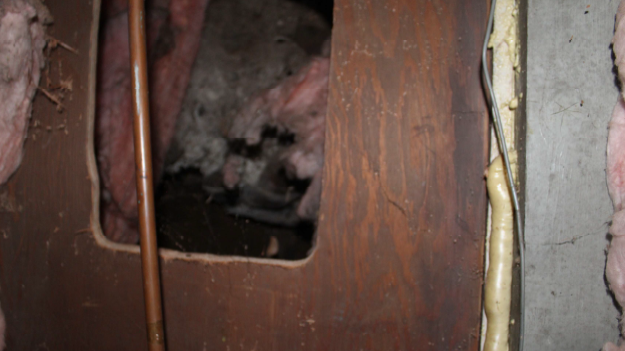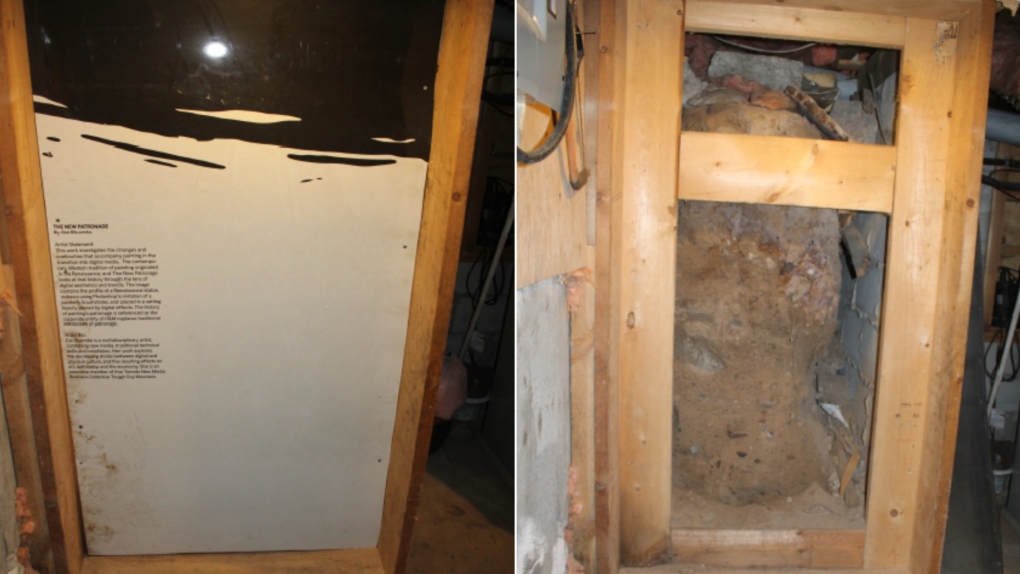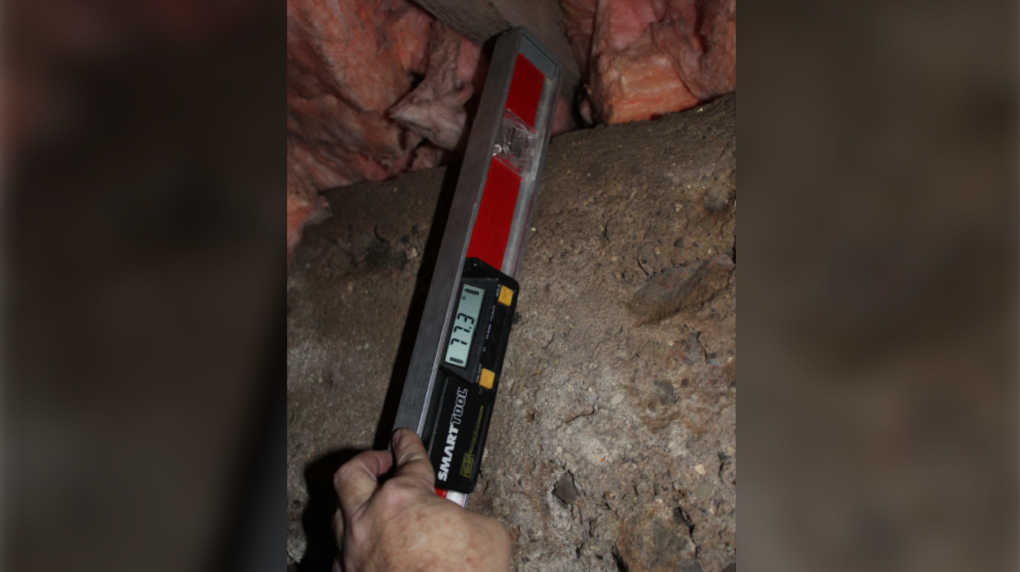Ontario woman says she was sold 'crumbling' house despite home inspection
As Kim Sandford put away her China dishes after Christmas dinner in 2018, she noticed her cabinet doors refused to shut.
Sandford, a 59-year-old retired nurse from a small community near Kawartha Lakes, didn’t think much of it at the time, but would soon learn the problem ran deep.
Her house, she told CTV News Toronto, was sloping and sinking into the ground.
Now six years later, Sandford said she’s drained her savings in a legal pursuit to hold the former owner and home inspector responsible for what she claims was an attempt to hide the home’s crumbling foundation.
“It’s completely taken everything we have,” Sandford said. “We’re in debt. We have no savings left. We’ve gone without food to pay bills.”
In the summer of 2018, Sandford and her husband bought the three-bedroom century-old house in the Kawarthas for $285,000.
Before making the purchase, they hired a home inspector to examine the property. He produced a 46-page report which found the structure to be in compliance with the Ontario Association of Home Inspectors standards of practice.
Though Sandford didn’t know it at the time, her faulty cabinets were only the beginning of her troubles. In the months that followed, she said she started having to wrap herself in an electric blanket to get through the winter. No matter how high she turned her furnace, heat continued to escape the home.
Frustrated, Sandford’s husband soon descended to the basement in search of the issue.
He cut a small hole in what he believed to be an exterior wall, but instead, discovered an opening into the home’s foundation, filled with crumbling rubble and boulders.
 An opening cut in a wood panel showing the collapsed stone rubble foundation behind the wood panel, according to an engineer's report.
An opening cut in a wood panel showing the collapsed stone rubble foundation behind the wood panel, according to an engineer's report.
“You could tell once upon a time it was a wall,” Sandford said. “It was supposed to be holding up the house.” The two storeys above are essentially airborne, she said.
On the other side of the basement wall, beneath a deck that wrapped around the house, he also found a gaping hole where the brutal breeze gust inside, she said. “You could walk right in,” Sandford added.
An engineer’s report conducted in June 2022 to determine the extent of the damage showed photographs of a “collapsed” and “dangling” stone rubble foundation “sloping” inward.
“It’s like a seesaw with no weight on one side,” Sandford said.
 View inside of wood frame after engineers removed metal panel. When reached for comment, the former owners said they could not discuss the matter while it was before the courts, but pointed to a statement of defence dated July 2021, which claims the home was sold on an “as-is” basis.
View inside of wood frame after engineers removed metal panel. When reached for comment, the former owners said they could not discuss the matter while it was before the courts, but pointed to a statement of defence dated July 2021, which claims the home was sold on an “as-is” basis.
The former owners never lived in the home, the claim states, and instead rented it out to tenants after purchasing it in 2011. In the statement, they maintain they made no attempt to “fraudulently or negligently conceal” any issues with the home, and that the wall in question pre-dated their ownership.
The claim says the contract stated the buyer would be responsible for repair costs after closing, and that the listing had communicated the home needed work, with tenants reporting moisture in the basement and garage.
 An engineer measuring the slope of inward movement of the stone rubble foundation.While the MLS listing did say the home would be sold on an “as-is” basis, Sandford said the actual contract of purchase made no such mention.
An engineer measuring the slope of inward movement of the stone rubble foundation.While the MLS listing did say the home would be sold on an “as-is” basis, Sandford said the actual contract of purchase made no such mention.
One of the core principles of real estate law can be summarized by the phrase “buyer beware,” says Bob Aaron, a Toronto real estate lawyer independent of the proceedings.
Simply put, buyers make purchases at their own risk.
Unless the sellers knew and hid defects that made the property dangerous or uninhabitable, they are under no obligation to disclose anything to the buyer, Aaron added.
“They are going to have to prove that there was a misrepresentation,” he said.
When it comes to home inspecting, he added that it’s not an examiner’s job to rip out walls and uncover deficiencies with a house, but rather, the process is observational, and nonintrusive. The company Sandford hired did not respond to requests from CTV News Toronto.
“Home inspectors inspect what they see, they don’t inspect what they can’t see,” Aaron said.
While Sandford’s legal action continues, so does a lingering fear that her house will one day crumble completely. She still loves her home, but feels it’s no longer a safe haven.
“You’re living in your stress. You can’t go to a safe spot, because the safe spot is your house,” Sandford said.
“I just want everyone to know that this can happen to them. This is how badly you can get burned.”
CTVNews.ca Top Stories

W5 Investigates A 'ticking time bomb': Inside Syria's toughest prison holding accused high-ranking ISIS members
In the last of a three-part investigation, W5's Avery Haines was given rare access to a Syrian prison, where thousands of accused high-ranking ISIS members are being held.
'Mayday!': New details emerge after Boeing plane makes emergency landing at Mirabel airport
New details suggest that there were communication issues between the pilots of a charter flight and the control tower at Montreal's Mirabel airport when a Boeing 737 made an emergency landing on Wednesday.
BREAKING Class-action lawsuit on 'opioid-related wrongs': Court dismisses drug companies' appeal
The Supreme Court of Canada on Friday dismissed the appeal of a class-action lawsuit against major drug makers and distributors.
Cucumbers sold in Ontario, other provinces recalled over possible salmonella contamination
A U.S. company is recalling cucumbers sold in Ontario and other Canadian provinces due to possible salmonella contamination.
Irregular sleep patterns may raise risk of heart attack and stroke, study suggests
Sleeping and waking up at different times is associated with an increased risk of heart attack and stroke, even for people who get the recommended amount of sleep, according to new research.
Real GDP per capita declines for 6th consecutive quarter, household savings rise
Statistics Canada says the economy grew at an annualized pace of one per cent during the third quarter, in line with economists' expectations.
Nick Cannon says he's seeking help for narcissistic personality disorder
Nick Cannon has spoken out about his recent diagnosis of narcissistic personality disorder, saying 'I need help.'
California man who went missing for 25 years found after sister sees his picture in the news
It’s a Thanksgiving miracle for one California family after a man who went missing in 1999 was found 25 years later when his sister saw a photo of him in an online article, authorities said.
As Australia bans social media for children, Quebec is paying close attention
As Australia moves to ban social media for children under 16, Quebec is debating whether to follow suit.

































